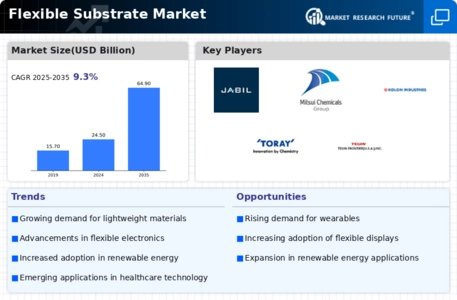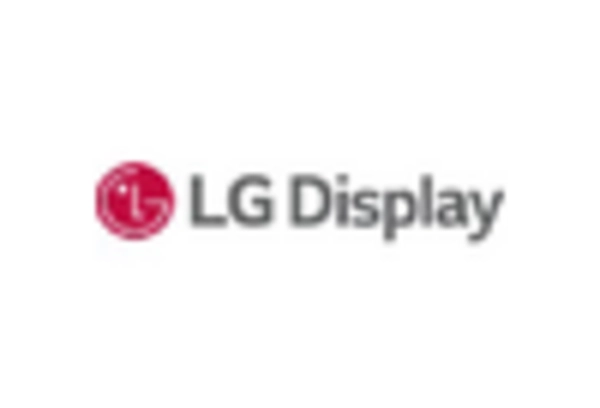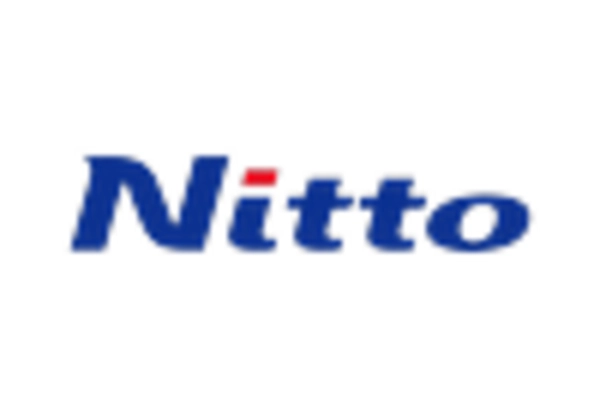Advancements in Display Technologies
The evolution of display technologies, particularly in the realm of smartphones and televisions, significantly influences the Flexible Substrate Market. Flexible displays, which offer enhanced viewing experiences and design versatility, are increasingly being adopted by manufacturers. The market for flexible displays is anticipated to grow at a compound annual growth rate of over 20% in the coming years. This growth is driven by consumer preferences for thinner, lighter devices that do not compromise on performance. As manufacturers strive to create more innovative products, the demand for flexible substrates that can support these advanced display technologies is expected to rise, thereby fostering growth within the Flexible Substrate Market.
Increased Focus on Energy Efficiency
The Flexible Substrate Industry. As industries seek to reduce their carbon footprints, flexible substrates are being recognized for their potential in energy-efficient applications, particularly in solar panels and energy harvesting devices. The market for flexible solar panels is projected to grow significantly, with estimates suggesting a value of over 10 billion USD by 2027. This trend is prompting manufacturers to explore innovative flexible materials that can enhance energy conversion efficiency while being lightweight and adaptable. Consequently, the demand for flexible substrates is likely to increase as industries prioritize sustainable solutions, thereby benefiting the Flexible Substrate Market.
Growth of the Internet of Things (IoT)
The proliferation of the Internet of Things (IoT) is a transformative force driving the Flexible Substrate Market. As more devices become interconnected, the need for flexible and lightweight substrates that can accommodate various sensors and communication technologies is becoming increasingly apparent. The IoT market is expected to reach over 1 trillion USD by 2026, indicating a substantial opportunity for flexible substrate applications. This growth necessitates the development of materials that can support the miniaturization of electronic components while ensuring reliability and performance. As a result, the Flexible Substrate Market is likely to experience heightened demand as manufacturers seek to create innovative solutions for the expanding IoT ecosystem.
Rising Demand for Wearable Electronics
The increasing consumer interest in wearable electronics is a pivotal driver for the Flexible Substrate Market. As health and fitness tracking becomes more prevalent, manufacturers are seeking lightweight and flexible materials to enhance comfort and usability. According to recent data, the wearable technology market is projected to reach approximately 100 billion USD by 2026, indicating a robust growth trajectory. This surge in demand necessitates the development of flexible substrates that can accommodate various electronic components while maintaining durability and performance. Consequently, companies are investing in research and development to create innovative flexible materials that meet the specific requirements of wearable devices, thereby propelling the Flexible Substrate Market forward.
Emerging Applications in Automotive Sector
The automotive sector is witnessing a paradigm shift towards the integration of advanced technologies, which serves as a significant driver for the Flexible Substrate Market. With the rise of electric vehicles and autonomous driving technologies, there is an increasing need for flexible substrates that can support various electronic systems, including sensors and displays. The automotive flexible electronics market is projected to grow at a compound annual growth rate of over 15% in the next few years. This growth is attributed to the demand for lightweight materials that enhance vehicle efficiency and performance. As automotive manufacturers continue to innovate, the Flexible Substrate Market is poised to benefit from the increasing adoption of flexible materials in vehicle design and functionality.


















Leave a Comment